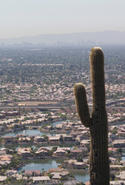In the heart of downtown Indianapolis lies a recently constructed monolith, the envy of other cities aspiring for new digs for their NFL football team. Lucas Oil Stadium has 63,000 seats and features a retractable roof allowing for comfort control during Indiana's fickle fall weather season. And for those urban enthusiasts in the crowd, when open, the roof provides a captivating view of an Indy skyline that in years past was barely visible to the naked eye. read more »
Urban Issues
Charlotte’s Expanding Financial Web
The takeover of Merrill Lynch by Charlotte-based Bank of America represents another step in the emergence of a true full-tilt competitor to New York as a financial capital. Already dominant in commercial banking, the acquisition places the North Carolina metropolis into the first ranks of cities in wealth management. read more »
A Critique of 'The Social Cost of NIMBYism'
Matthew Kiefer knows NIMBYs (Not-in-my-backyard). His essay on the social function of NIMBYism may be the best description of the phenomenon I’ve read. It is a dispassionate, clinical assessment by a physician who has seen this condition too many times. read more »
The Kids are All Ride
My eldest child tells me that when she arrived at an East Coast college her classmates—many of whom had never visited LA—would ask, “Does your family live in the city, or outside of it?” Her answer, she says, was always long — really long — and of eye-glazing complexity.
Anyone who has raised kids in the middle-class neighborhoods of multipolar LA might chuckle at the thought of trying to define urban or suburban. read more »
- Login to post comments
Keeping Kids Downtown - A Philadelphia Approach
As children return to classes in Philadelphia this week, more than half of the kindergarteners attending three downtown public elementary schools will come from their immediate middle-income neighborhoods. Three private schools that also serve this area, drawing over 70 percent of their enrollment from downtown families, are bursting at the seams. Having doubled and tripled pre-school programs over the last half decade, each is now physically expanding to accommodate the 11,200 children, born to downtown parents between 2000 and 2005. read more »
Cities, Children and the Future
By Joel Kotkin and Mark Schill
“Suburbs,” the great urbanist Jane Jacobs once wrote, “must be a difficult place to raise children.” Yet, as one historian notes, had Jacobs turned as much attention to suburbs as she did to her beloved Greenwich Village, she would have discovered that suburbs possessed their own considerable appeal, particularly for those with children.
Although some still hold onto the idea that suburbs are bad places to raise children, in virtually every region of the country, families with children are far more likely to live in suburbs than in cities. read more »
New Urbanist Cities, Class and Children
The United States has experienced a revolutionary change in social structure over the last 25 years, and this in turn has led to a significant change in settlement, especially the geography of many metropolitan areas.
At the risk of over-generalization, our society has shifted from a structure based on economic class to one based more on education and social values. read more »
Understanding Phoenix: Not as Sprawled as You Think
Phoenix may be one of the nation’s most misunderstood urban areas. The conventional wisdom is that Phoenix is one of the most suburbanized (or if the pejorative is preferred, “sprawling”) urban areas in the United States. Not so. According to 2000 U.S. Census data, Phoenix ranked number 10 in population density out of the 36 urban areas with more than one million in population. read more »
The Phoenix Lament (with apologies to J. K. Rowling)
Fifty years ago, Phoenix was Tiny Town in the Desert, smaller than Oshkosh or Santa Fe today. Now, it is larger than Philadelphia and the metro area has the bulk of Arizona’s population. That does not mean it gets any respect; on the contrary, it is, to many, a joke, with all of Los Angeles’ traffic and smog but without the ocean, the celebrities or the Lakers. read more »
- Login to post comments
Phoenix: Is John McCain’s Hometown Down for the Count?
By Joel Kotkin and Mark Schill
Much has been said about the rootlessness of our two Presidential aspirants, but both men have spent their political lifetimes representing real places and specific constituencies. Newgeography.com has already looked into the realities shaping Senator Barack Obama’s adopted hometown of Chicago. Now we turn to the city that has most shaped Senator John McCain’s career: Phoenix. read more »





















